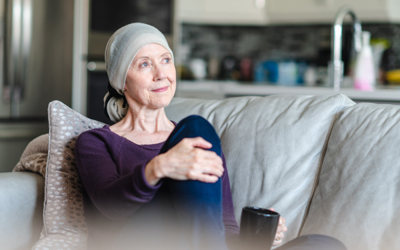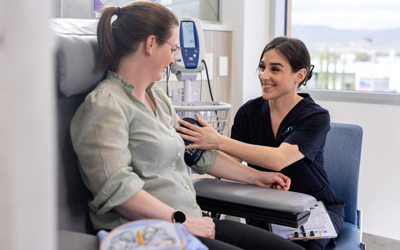What are the treatment options for lung cancer?
The primary treatment options for lung cancer include surgery, thermal ablation, radiotherapy, chemotherapy and targeted therapies. The type of treatment you receive will depend on a number of different considerations, such as the type of lung cancer you have, its stage, your overall health and your treatment preferences. This page aims to give you a comprehensive overview of how lung cancer treatment works.

Surgery for lung cancer
There are many different surgical techniques that may be suitable for your lung cancer. The surgery you receive will depend on the size, stage and location of your cancer, your general health and level of lung function. Surgery can occur anywhere on the lung, which consists of five lobes (three lobes in the right lung and two lobes in the left lung).
-
Lobectomy
In this procedure, the surgical oncologist removes the entire lobe within the lung that contains cancer. This is a treatment option for early-stage non-small cell lung cancer which is contained within a single lobe.
-
Pneumonectomy
This surgery involves the removal of the entire lung and may be performed if the cancer is located near the centre of the chest.
-
Wedge resection
Also known as a segmentectomy, this procedure is recommended when you do not have enough lung function to undergo a lobectomy and involves the removal of a small section of the affected lobe from the lung, rather than the entire lobe.
-
Lymphadenectomy
This involves the removal of any nearby lymph nodes that may have been affected by cancer.
The two approaches for lung cancer surgery, performed under general anaesthesia, include:
Thoracotomy – Where a long incision is made through the skin and between the ribs to access the lung
Video-assisted thoracoscopic surgery (VATS) – A minimally invasive procedure (keyhole surgery) that uses several small incisions in the chest wall to access the lung. This procedure often results in less postoperative pain and complications, a shorter hospital stay and faster recovery compared to a thoracotomy
Download your free Lung Cancer Treatment Guide
Be informed, feel empowered. Our free guide will help you make decisions about your, or your loved ones, care.

Radiotherapy for lung cancer
Radiotherapy for lung cancer is commonly delivered in combination with chemotherapy.
Types of radiotherapy used for people with lung cancer include:
Stereotactic radiation therapy
Stereotactic radiotherapy to the lung is most commonly used to treat early-stage primary lung cancer or metastatic tumours that have spread from other organs in the body.
Stereotactic radiotherapy for lung cancer involves the use of specialised equipment to ensure the accurate representation of your breathing motion. During your simulation or CT appointment, the radiation therapists will monitor and record your breathing pattern so that we can replicate it each day for treatment. By knowing exactly where the tumour moves during your breathing cycles, we can reduce the amount of healthy lung being irradiated by focusing and targeting the treatment beams precisely at the moving tumour.
Thermal ablation for lung cancer
If you have early lung cancer which involves small tumours, you may receive thermal ablation rather than surgery. This involves the insertion of a needle-like probe into the tumour in your lung, guided by CT scans, which uses heat from radio waves to destroy cancerous cells.
Chemotherapy for lung cancer
Chemotherapy uses a range of drugs to kill and slow the growth of lung cancer cells. These drugs may be delivered at any stage of your lung cancer treatment, from shrinking large tumours before surgery to destroying potential remaining cancer cells after surgery.
Learn more about chemotherapy and how it is delivered.
Chemotherapy treatment for lung cancer takes place over several sessions, which is known as a cycle. Your care team will walk you through how many cycles you may need for your course of treatment, with most people completing chemotherapy in a period of three to four months.
Common chemotherapy medicines
There are a number of different chemotherapy drugs that are used to treat lung cancer. These drugs are typically combined based on factors such as your cancer’s stage and spread. Some of the drugs include:
-
Carboplatin and cisplatin
These work by interfering with the genetic material (DNA and RNA) within lung cancer cells to stop their growth and spread. They are given by intravenous infusion, usually in combination with other chemotherapy drugs. Carboplatin and cisplatin can be used as adjuvant therapy after surgery for locally advanced or advanced lung cancer and are typically given every three weeks.
-
Docetaxel and paclitaxel
These are chemotherapy drugs known as taxanes, which work by disrupting cell division and other normal cell activity, causing the cancer cells to die. They are given by intravenous infusion every three weeks in combination with other chemotherapy drugs and radiation therapy to treat locally advanced or advanced lung cancer.
-
Gemcitabine
Gemcitabine works by interfering with the DNA synthesis within cancer cells, which stops or slows their growth. It is given by intravenous infusion every one to three weeks, often in combination with other chemotherapy drugs, to treat locally advanced or advanced lung cancer.
-
Pemetrexed
This is a chemotherapy drug called an antifolate, which stops cancer cells from growing and dividing by blocking their DNA. It is used in the treatment of advanced (metastatic) lung cancer and is given by intravenous infusion every three weeks.
-
Vinorelbine
Vinorelbine limits cancer cell growth by interfering with the processes that cause cancer cells to divide and grow. It is typically used in combination with other chemotherapy drugs to treat locally advanced or advanced lung cancer, and is given by intravenous infusion every three weeks. It may also be used as an adjuvant therapy following surgery, together with other chemotherapy drugs.
-
Etoposide, topotecan and irinotecan
These chemotherapy drugs work by blocking an enzyme called topoisomerase, which is needed for cancer cells to reproduce and grow. They are often used in combination with other chemotherapy drugs to treat advanced lung cancer, and can also be given together with radiation therapy (chemoradiation). These drugs can be given by intravenous infusion, or orally as a tablet or capsule, once daily every three weeks.
Targeted therapies for lung cancer
Lung cancer cells are made up of multiple different building blocks, including genes and proteins. Targeted therapy focuses on targeting specific parts of these building blocks, known as modular targets, to stop lung cancer cells from growing and spreading.
For non-small cell lung cancer (NSCLC), targeted therapies can be used to stop modular targets such as EGFR, ALK and the KRAS G12C gene (found in 13% of cases) to prevent the cancer’s growth and spread6. Targeted therapies are only effective for certain lung cancers which have these modular targets. Your care team will examine the make-up of your cancer cells to determine if targeted therapies are suitable for you.
Kinase inhibitors are targeted therapy drugs that work by blocking the kinase enzyme, which promotes lung cancer cell growth and helps provides nutrients for these cancer cells to grow. Blocking this enzyme helps to stop the growth and spread of lung cancer cells. Kinase inhibitors are typically used in the treatment of advanced lung cancer and are taken orally as a tablet or capsule once or twice daily.
Types of kinase inhibitors include:
Alectinib
Afatinib
Brigatinib
Entrectinib
Lorlatinib
Osimertinib
Erlotinib
Gefitinib
Crizotinib
Immunotherapy for lung cancer
Immunotherapy trains the immune system to recognise and fight lung cancer cells, which may hide behind proteins known as “checkpoints”. Checkpoint inhibitors such as PD-L1 block these checkpoints, allowing the immune system to target lung cancer cells. Drugs such as CTLA-4 inhibitors can also stimulate the immune system and boost its performance. Immunotherapy is commonly used when your lung cancer has come back after initial treatment or has not responded to other methods.
Common immunotherapy medicines
Common immunotherapy drugs that are used to treat lung cancer include:
-
PD-L1 checkpoint inhibitors
(pembrolizumab, durvalumab, nivolumab, atezolizumab)
These are monoclonal antibodies which work by blocking a specific protein on immune system T cells, known as the PD-L1 checkpoint. They work by allowing your immune system to recognise and attack lung cancer cells. PD-L1 checkpoint inhibitors are used to treat locally advanced or advanced (metastatic) lung cancer and may be given alone or in combination with other chemotherapy drugs, or after chemoradiation depending on the type and stage of your lung cancer. They are administered by intravenous infusion every two to four weeks.
-
Ipilimumab
This is an anti-CTLA-4 monoclonal antibody which stimulates your immune system to fight lung cancer cells. It is usually given in combination with ipilimumab, and may also be given together with other chemotherapy drugs to treat advanced lung cancer.
-
Bevacizumab
This is a monoclonal antibody that binds to and blocks the protein known as vascular endothelial growth factor (VEGF), which promotes the growth of blood vessels that supply essential nutrients to cancer cells. When VEGF is blocked, cancer cells no longer receive the essential nutrients and oxygen that they need to grow and survive. Bevacizumab is used to treat advanced lung cancer and is given by intravenous injection every two to three weeks.
Clinical trials for lung cancer
Icon offers a wide range of clinical trials providing patients with access to new and evolving treatments. Clinical trials offer hope and opportunity and contribute to breakthroughs in treatment for future cancer patients.

Treatment by stage of lung cancer
There are two different types of lung cancer, known as non-small cell lung cancer (NSCLC) and small cell lung cancer (SCLC), which are staged in different ways. You may receive a number of different treatments based on the type, stage and size of your lung cancer.
Non-small cell lung cancer (NSCLC)
Stage 0 lung cancer
Stage 0 lung cancer is not technically cancer. This refers to management of carcinoma in situ (pre-cancerous tumours) and can usually be cured through surgical removal of part of the lobe of the lung (called a segmentectomy), as the cancer hasn’t invaded the deeper lung tissue yet. Alternatives to surgery include photodynamic therapy (PDT), laser therapy or brachytherapy.
Stage I lung cancer
Surgery is a common treatment for stage I lung cancer. The most common types of surgery are a lobectomy, sleeve resection or segmentectomy. Chemotherapy and/or radiotherapy may be recommended if the cancer has a high risk of returning after surgery. Alternative treatments for stage I lung cancer include stereotactic body radiotherapy or thermal ablation for those who are not fit enough or decline surgery.
Stage II lung cancer
Surgery is usually the first treatment option for stage II lung cancer. The most common types of surgery for stage II lung cancer are a lobectomy or sleeve resection, but in more severe cases, a pneumonectomy may be recommended. During surgery, affected lymph nodes will also be removed.For early-stage lung cancer (stage I and II), further treatment with chemotherapy or radiotherapy may be required if the cancer is deemed more advanced than originally thought following surgery.
Stage III lung cancer
Stage III lung cancer is broken into two subcategories: Stage IIIA and Stage IIIB. For Stage IIIA, a combination of chemotherapy and/or radiotherapy may be delivered, followed by surgery. The treatment will depend on your overall health, the size and location of your tumour(s), as well as the spread of your cancer into surrounding areas. Immunotherapy is also an option for some patients. Surgery can’t completely remove the cancer when lung cancer has progressed to Stage IIIB. You may be treated with chemotherapy and radiotherapy , followed by immunotherapy. When chemotherapy and radiotherapy aren’t suitable treatment options, immunotherapy may be prescribed as a first course of treatment.
Stage IV lung cancer
Like stage III lung cancer, stage IV lung cancer is split into two subcategories: stage IVA and stage IVB. In both categories, the lung cancer has spread and becomes hard to cure. Depending on the extent of the spread, treatment may focus on palliative care to extend life expectancy and improve quality of life. Treatment options include surgery, chemotherapy, radiotherapy , immunotherapy, photodynamic therapy (PDT), laser therapy and targeted therapies. People with stage IVB lung cancer will usually be treated with targeted therapies or chemotherapy first.
Small cell lung cancer (SCLC)
Limited SCLC lung cancer
If you have a single tumour in your lung, you may receive surgery first to remove the cancer followed by chemotherapy and radiotherapy. If surgery isn’t an option, then chemotherapy and radiotherapy are the primary treatment methods for limited SCLC. Following this, preventative radiotherapy to the brain is often offered, as it is common for SCLC to spread to the brain.
Extensive SCLC lung cancer
Extensive SCLC lung cancer can no longer be treated through surgery or radiotherapy. Chemotherapy and immunotherapy are often the primary treatment options to relieve your symptoms and extend life expectancy, with the focus now moving to palliative care. In some cases, radiotherapy may be delivered if initial chemotherapy and/or immunotherapy treatments are effective. This also includes preventative radiotherapy to the brain.










